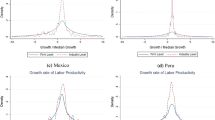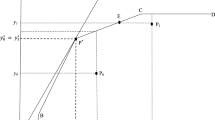Abstract
This study investigates the parametric drift of a Verdoorn-type relationship across Japan's center-periphery continuum, using prefecture-level data for the 1965–75 time horizon. Our results indicate that in and around Japan's core neutral technological progress and capital deepening tend to be higher, whereas scale and external economies tend to be lower. This spatial variation is consistent with product cycle and regional dynamics theories. The study implements the expansion method techniques and research philosophy.
Similar content being viewed by others
References
Berry, B. J. L., and Dahman, D. 1977. Population redistribution in the United States in the 1970's.Population and Development Review 3: 443–71.
Bureau of Statistics, Office of the Prime Minister. 1971.Japanese statistical yearbook. Tokyo: Japan Statistical Association.
Casetti, E. 1972. Generating models by the expansion method: applications to geographical research.Geographical Analysis 4: 81–91.
Casetti, E. 1982a. Mathematical modelling and the expansion method. InStatistics for geographers and social scientists, ed. R. B. Mandal, pp. 81–95. New Delhi, India: Concept Publishing Company.
Casetti, E. 1982b. Technological progress, capital deepening, and manufacturing growth in the USA: a regional analysis.Environment and Planning A 14: 1577–85.
Casetti, E. 1984a. Peripheral growth in mature economies.Economic Geography 60: 122–31.
Casetti, E. 1984b. Verdoorn Law and the components of manufacturing productivity growth: a theoretical model and an analysis of US regional data. InRegional and industrial development theories, models and empirical evidence, eds. A. E. Andersson, W. Isard, and T. Puu, pp. 295–308. New York: Elsevier Science Publishers B.V. (North Holland).
Casetti, E. 1986. The dual expansion method: an application for evaluating the effects of population growth on development.IEEE Transactions on Systems, Man, and Cybernetics 16: 29–39.
Casetti, E., and Jones, J. P., III. 1983. Regional shifts in the manufacturing productivity response to output growth: Sunbelt versus Snowbelt.Urban Geography 4: 285–301.
Casetti, E., and Jones, J. P., III. 1987. Spatial applications of the expansion method paradigm. InQuantitative analysis in geography, eds. C. Dufornaud and D. Dudycha, pp. 121–36. Waterloo, Ontario, Canada: University of Waterloo.
Cornwall, J. 1976. Diffusion, convergence and Kaldor's Laws.The Economic Journal 86: 307–14.
Cripps, T. F., and Tarling, R. J. 1973.Growth in advanced capitalist economies, 1950–1970. Cambridge: Cambridge University Press.
Denison, E. E. 1967.Why growth rates differ: postwar experience in nine Western countries. Washington, D.C.: Brookings Institution.
Dixon, R. J., and Thirlwall, A. P. 1975.Regional growth and unemployment in the United Kingdom. New York: Macmillan.
Fabricant, S. 1942.Employment in manufacturing 1899–1939. New York: National Bureau of Economic Research.
Gomulka, S. 1983. Industrialization and the rate of growth: Eastern Europe 1955–75.Journal of Post Keynesian Economics 5: 388–96.
Harris, C. D. 1982. The urban and industrial transformation of Japan.Geographical Review 72: 50–89.
Hirschman, A. O. 1958.The strategy of economic development. New Haven, Connecticut: Yale University Press.
Kaldor, N. 1967.Strategic factors in economic development. Ithaca, New York: Cornell University, New York State School of Industrial and Labor Relations.
Kaldor, N. 1970. The case for regional policies.Scottish Journal of Political Economy 17: 337–48.
Kendrick, J. W. 1977.Understanding productivity. An introduction to the dynamics of productivity change. Baltimore, Maryland: Johns Hopkins University Press.
Kennedy, K. A. 1971.Productivity and industrial growth. The Irish experience. Oxford: Clarendon Press.
McCombie, J. S. L. 1982. Economic growth, Kaldor's laws and the static-dynamic Verdoorn Law paradox.Applied Economics 14: 279–94.
McCombie, J. S. L. 1985. Increasing returns and the manufacturing industries: some empirical issues.The Manchester School of Economic and Social Studies 53: 55–75.
McCombie, J. S. L., and De Ridder, J. R. 1984. The Verdoorn Law controversy: some empirical evidence using U.S. state data.Oxford Economic Papers 36: 268–84.
Ministry of International Trade and Industry, Research and Statistics Division, Minister's Secretariat. 1967.Census of manufactures 1965, report by industries. Tokyo: Ministry of International Trade and Industry.
Ministry of International Trade and Industry, Research and Statistics Division, Minister's Secretariat. 1977.Census of manufactures 1975, report by industries. Tokyo: Ministry of International Trade and Industry.
Miyakawa, Y. 1980. The location of modern industry in Japan. InGeography of Japan, ed. The Association of Japanese Geographers. Tokyo: Teikoku-Shoin, pp. 265–98.
Murata, K. 1980. The formation of industrial areas. InGeography of Japan, ed. The Association of Japanese Geographers. Tokyo: Teikoku-Shoin, pp. 246–64.
Myrdal, G. M. 1957.Economic theory and underdeveloped regions. London and New York: Methuen.
Norton, R. D., and Rees, L. 1979. The product cycle and the spatial decentralization of American manufacturing.Regional Studies 13: 141–51.
Parikh, A. 1978. Differences in growth and Kaldor's Law.Economica 45: 83–91.
Richardson, H. W. 1980. Polarization reversal in developing countries.Papers of the Regional Science Association 45: 67–85.
Rowthorn, R. E. 1975. What remains of Kaldor's Law?The Economic Journal 85: 10–19.
Rowthorn, R. E. 1979. A note on Verdoorn's Law.The Economic Journal 89: 131–33.
Sternlieb, G., and Hughes, J. W., eds. 1975.Post-industrial America: metropolitan decline and interregional job shifts. New Brunswick, New Jersey: The Center for Urban Policy Research.
Tabuchi, T. 1988. Interregional income differentials and migration: their interrelationships.Regional Studies 22: 1–10.
Theil, H. 1963. On the use of incomplete prior information in regression analysis.Journal of the American Statistical Association 58: 401–14.
Theil, H. 1971.Principles of econometrics. New York: Wiley.
Theil, H., and Goldberger, A. S. 1961. On pure and mixed statistical estimation in economics.International Economic Review 2: 65–78.
Thirlwall, A. P. 1980. Rowthorn's interpretation of Verdoorn's Law.The Economic Journal 90: 386–88.
Verdoorn, P. J. 1949. Fattori che Regolano lo Sviluppo Economico della Produttivita del Lavoro.L'Industria 1: 45–53.
Verdoorn, P. J. 1980. Verdoorn's Law in retrospect: a comment.The Economic Journal 90: 382–85.
Vernon, R. 1966. International investments and international trade in the product cycle.Quarterly Journal of Economics 81: 190–207.
Vining, D. R., and Kontuly, T. 1978. Population dispersal from major metropolitan regions: an international comparison.International Regional Science Review 3: 49–73.
Vining, D. R., and Pallone, R. 1982. Migration between core and peripheral regions: a description and tentative explanation of the patterns in 22 countries.Geoforum 13: 339–410.
Author information
Authors and Affiliations
Rights and permissions
About this article
Cite this article
Casetti, E., Tanaka, K. The spatial dynamics of japanese manufacturing productivity: An empirical analysis by expanded verdoorn equations. Papers in Regional Science 71, 1–13 (1992). https://doi.org/10.1007/BF01538656
Issue Date:
DOI: https://doi.org/10.1007/BF01538656




